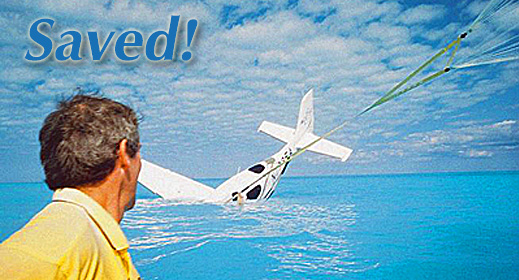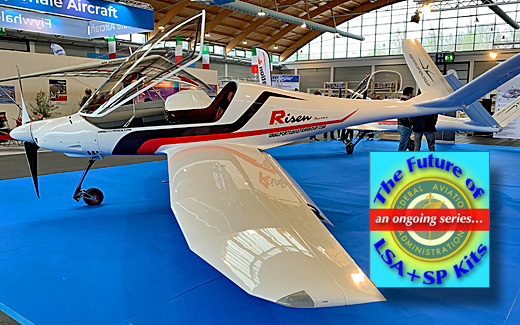 Could 2020 bring a new description of aircraft under the LSA banner? Could this include greater capabilities and opportunities? Could you get the airplane you want for less? When?! Yes, yes, and yes …but probably not as soon as you want. The regulation may not emerge in 2020 but whatever the announcement date, what could be coming and how will it affect you?
We still have more to report from Sun ‘n Fun and Aero 2019 — and we will! — but numerous conversations at each event have pointed to another topic of keen interest to many: “What’s coming and when?”
Manufacturers of aircraft are among the most interested to hear more, but so are individual pilots and all the organizations and other enterprises that serve the recreational aircraft market. In this article, let’s take a closer look. (More articles will follow.)
EAA has adeptly branded their good work to some of these ends as MOSAIC, or Modernization of Special Airworthiness Certificates.
Could 2020 bring a new description of aircraft under the LSA banner? Could this include greater capabilities and opportunities? Could you get the airplane you want for less? When?! Yes, yes, and yes …but probably not as soon as you want. The regulation may not emerge in 2020 but whatever the announcement date, what could be coming and how will it affect you?
We still have more to report from Sun ‘n Fun and Aero 2019 — and we will! — but numerous conversations at each event have pointed to another topic of keen interest to many: “What’s coming and when?”
Manufacturers of aircraft are among the most interested to hear more, but so are individual pilots and all the organizations and other enterprises that serve the recreational aircraft market. In this article, let’s take a closer look. (More articles will follow.)
EAA has adeptly branded their good work to some of these ends as MOSAIC, or Modernization of Special Airworthiness Certificates.What’s Coming to Light-Sport Aircraft and Sport Pilot Kit Aircraft in 2020 (or so)?
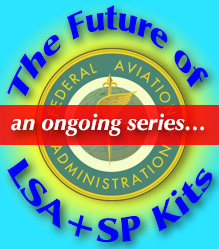
We still have more to report from Sun ‘n Fun and Aero 2019 — and we will! — but numerous conversations at each event have pointed to another topic of keen interest to many: “What’s coming and when?”
Manufacturers of aircraft are among the most interested to hear more, but so are individual pilots and all the organizations and other enterprises that serve the recreational aircraft market. In this article, let’s take a closer look. (More articles will follow.)
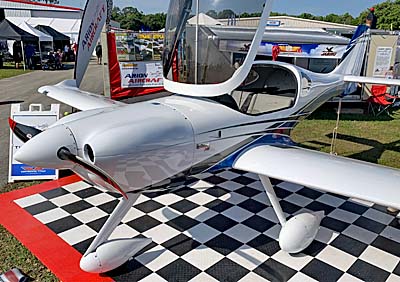
Arion‘s Lightning XS, powered by Continental’s 180-horsepower Titan engine, is a huge performer with fixed landing gear. This is a kit, although Arion also makes a ready-to-fly Special LSA version called LS-1.
EAA has adeptly branded their good work to some of these ends as MOSAIC, or Modernization of Special Airworthiness Certificates. The spelled-out name is rather dull but MOSAIC is savvy as you can remember it and say it quickly.
LAMA has been working with FAA personnel taking a different tactic (earlier article about LAMA initiatives) while coordinating with EAA, AOPA, and GAMA in its advocacy efforts.
Each organization’s work has value and may converge into what FAA finally offers.
Builder Assist Centers
Nearly everyone in recreational aviation is by now well aware that the country is dotted with enterprises calling themselves a Builder Assist Center. This was not always the case.
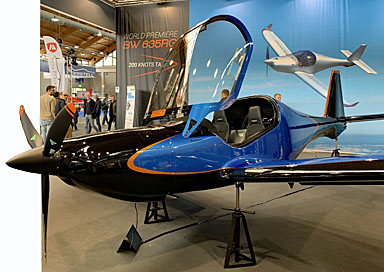
Sweden’s Blackwing is a retractable two seater with in-flight adjustable propeller. These qualities require a kit-built aircraft in America today. Blackwing is also available with fixed gear that could (but does not yet) qualify as an SLSA.
In short, a Build Center means a buyer of a kit aircraft can find assistance, tools, a facility, jigs, and more at a physical location where they can assemble their chosen kit. Build Centers have proliferated in recent years and a brief background explains why.
Back in the 1950s Paul Poberezny and his entourage of airplane enthusiasts willing to build their own flying machine had a tougher path. Homebuilding was a new idea then. In the earliest days you bought plans from a designer and you “scratch built” your airplane by collecting elements and fabricated those you could not buy.
Scratch building was difficult and took a long time but it was highly educational. Indeed, that’s how Paul and EAA sold the idea to FAA. (Great job, Paul and fellow builders!)
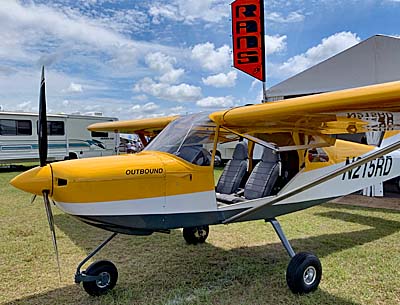
Rans offers their S-21 Outbound in either tricycle gear as shown or in taildragger with a choice of powerplants. You can buy this aircraft assembled or in kit form.
Companies like Van’s, Rans, and many others slowly evolved the plans-built concept into kits that attempted to speed construction by offering parts, then whole subassemblies, and later, quick-build kits. It took years as FAA and industry worked out the details. Those kits continually got better, more recently including precision match-hole construction that provides parts a builder can more accurately join together without costly jigs. Homebuilding was still time consuming but the process got far easier. Finished aircraft also got better with factory-made parts fitting more perfectly than ones a homebuilder cut or welded him or herself.
Over decades this lead to locations where now-qualified builders helped other builders. Finally, people got into the business of helping people. This may not have been exactly what FAA (or Paul) envisioned back in the ’50s and ’60s but they allowed a great expansion of the idea as part of the experimentation and education of pilot builders.
Today, Experimental aircraft are a substantial part of the overall U.S. aircraft fleet (approaching 20% of all aircraft!). Some are marvelous, fast, sophisticated flying machines that Joe Homebuilder probably should not build on his or her own. FAA recognized the value of professional help and did not discourage the effort.
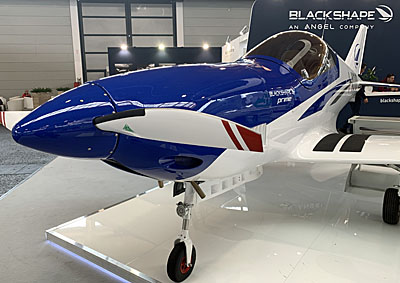
Blackshape‘s Prime is another aggressive tandem seating European hot rod with retractable gear. In the USA today it would have to be assembled from a kit.
As aircraft got more capable (faster, larger, better equipped, more complex) build centers become even more valuable. Some kits were so challenging for the average builder that professionals began to assist them. It took time but these build centers stayed within the limits of what FAA permitted under the so-called 51% rule.
Now, with a new regulation in development, the agency may expand on the Professional Builder Center concept greatly.* A pilot seeking any number of fast, bush, or amphibious aircraft — commonly in kit form to deliver a vast array of configurations — will have a far easier time assembling it and the resulting aircraft will almost surely be better.
Then What?
Once you’ve got one of these speedy aircraft built, how can you learn to fly it or transition from a different aircraft you presently fly? Can you hire someone?
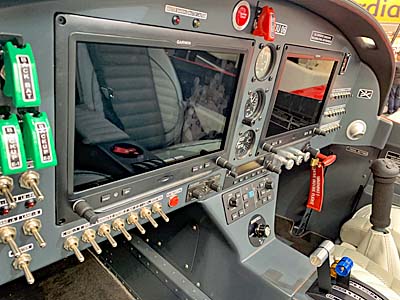
Build centers can help individuals achieve highly finished looks like this new Bristell with its handsome flush-mounted avionics.
Yes, you can. This article details another positive change FAA has made to better serve the LSA and Sport Pilot kit community. As this series — “The Future of LSA+SP Kits” — progresses we’ll cover other aspects of the regulation to come and how it may affect both producers and buyers.
However, implementation of a new rule is still years in the future. Until then, you have many marvelous choices in fine fully-built LSA, kit aircraft, and ultralights …so go enjoy the skies!
* DISCLAIMER — As with following articles in this series, what is described here is the best available information at the time of publication. In spring of 2019, FAA’s regulation is still in early stages of development and it is a huge, sweeping rule set that touches on many parts of the FARs. What finally emerges may or may not be as described here.
 Could 2020 bring a new description of aircraft under the LSA banner? Could this include greater capabilities and opportunities? Could you get the airplane you want for less? When?! Yes, yes, and yes …but probably not as soon as you want. The regulation may not emerge in 2020 but whatever the announcement date, what could be coming and how will it affect you?
We still have more to report from Sun ‘n Fun and Aero 2019 — and we will! — but numerous conversations at each event have pointed to another topic of keen interest to many: “What’s coming and when?”
Manufacturers of aircraft are among the most interested to hear more, but so are individual pilots and all the organizations and other enterprises that serve the recreational aircraft market. In this article, let’s take a closer look. (More articles will follow.)
EAA has adeptly branded their good work to some of these ends as MOSAIC, or Modernization of Special Airworthiness Certificates.
Could 2020 bring a new description of aircraft under the LSA banner? Could this include greater capabilities and opportunities? Could you get the airplane you want for less? When?! Yes, yes, and yes …but probably not as soon as you want. The regulation may not emerge in 2020 but whatever the announcement date, what could be coming and how will it affect you?
We still have more to report from Sun ‘n Fun and Aero 2019 — and we will! — but numerous conversations at each event have pointed to another topic of keen interest to many: “What’s coming and when?”
Manufacturers of aircraft are among the most interested to hear more, but so are individual pilots and all the organizations and other enterprises that serve the recreational aircraft market. In this article, let’s take a closer look. (More articles will follow.)
EAA has adeptly branded their good work to some of these ends as MOSAIC, or Modernization of Special Airworthiness Certificates.

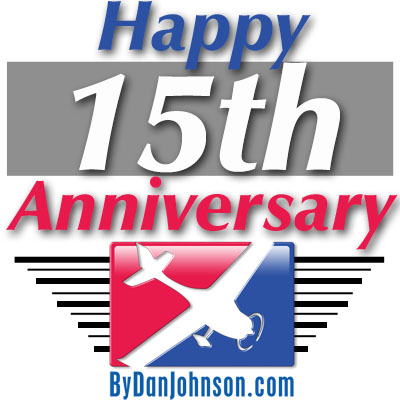 After the rush of daily reporting from
After the rush of daily reporting from 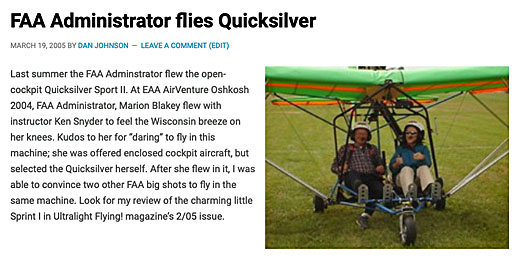

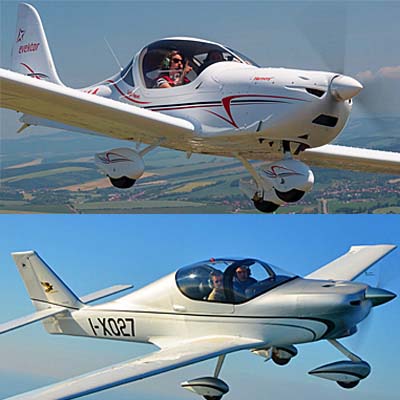 ByDanJohnson.com does not cover certified aircraft, commercial aviation, helicopters, airships, or space travel …although I find all those categories interesting. The good news for those segments is you have many great outlets, online or in print, that cover those activities in great detail. I’m happy we have them and I wish them the best. I know most of the journalists in this space and am humbled to be one of them.
ByDanJohnson.com does not cover certified aircraft, commercial aviation, helicopters, airships, or space travel …although I find all those categories interesting. The good news for those segments is you have many great outlets, online or in print, that cover those activities in great detail. I’m happy we have them and I wish them the best. I know most of the journalists in this space and am humbled to be one of them.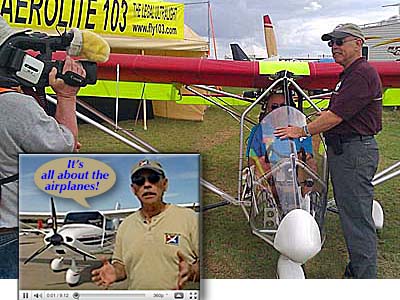
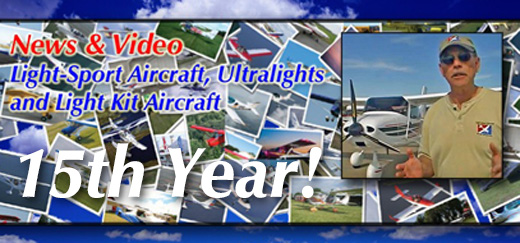
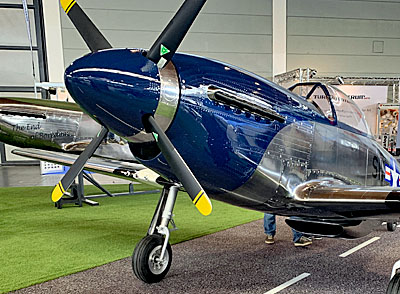 ScaleWings SW51
ScaleWings SW51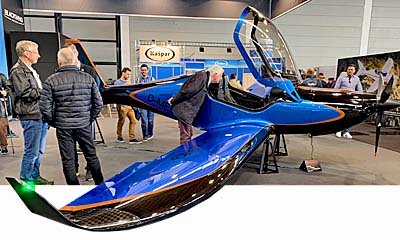 Blackwing 600RG
Blackwing 600RG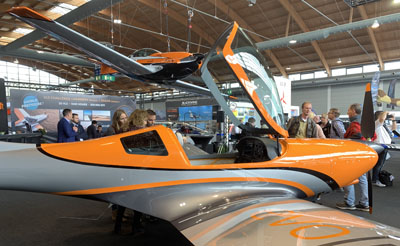 JMB Aircraft Update
JMB Aircraft Update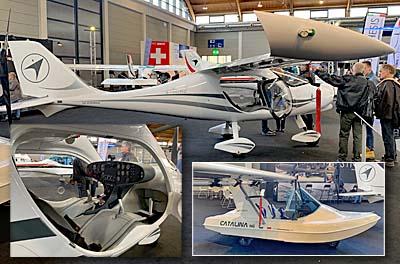 Fly Synthesis Synchro & Catalina
Fly Synthesis Synchro & Catalina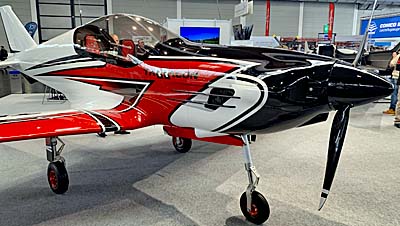 The stories from
The stories from 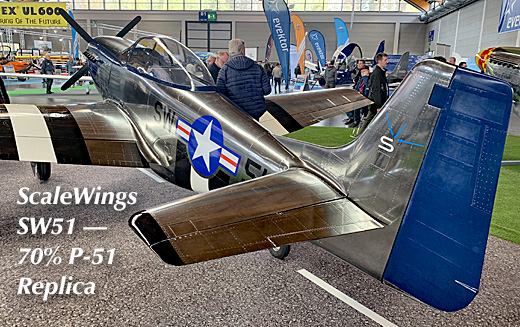
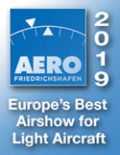 More from Aero as Day 3 closes. Because of the number on display — and because several readers asked — this post will focus on electric propulsion in two distinct forms. Whatever you think about electric as a means of lifting aircraft aloft, escaping its approach appears impossible. Experimentation is happening in all quarters. The following review is far from exhaustive; many other examples could be found at
More from Aero as Day 3 closes. Because of the number on display — and because several readers asked — this post will focus on electric propulsion in two distinct forms. Whatever you think about electric as a means of lifting aircraft aloft, escaping its approach appears impossible. Experimentation is happening in all quarters. The following review is far from exhaustive; many other examples could be found at 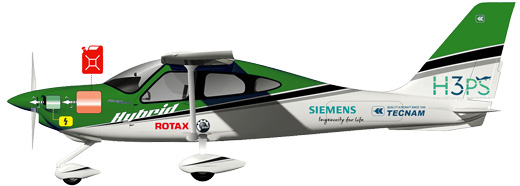 Beside taking the lead in this investigation, funded by the “European Union Horizon 2020 research and innovation programme,”
Beside taking the lead in this investigation, funded by the “European Union Horizon 2020 research and innovation programme,” 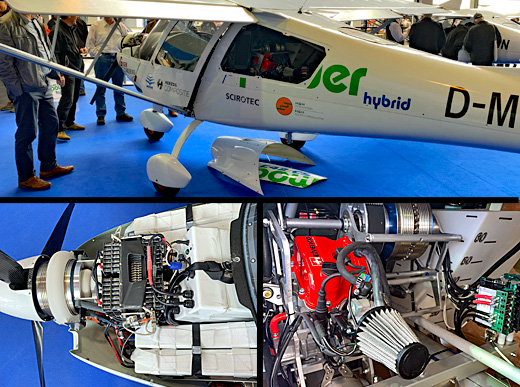 The big difference in this development compared to the H3PS project is that Toni flew the Comco Ikarus C-42 CS Elektro from his base near the factory to Aero. This hybrid is operating now. Technical information about the system was sparse on Toni’s website, however, a German-language video (below) shows the aircraft operated essentially the same as its fossil fuel-powered counterparts.
The big difference in this development compared to the H3PS project is that Toni flew the Comco Ikarus C-42 CS Elektro from his base near the factory to Aero. This hybrid is operating now. Technical information about the system was sparse on Toni’s website, however, a German-language video (below) shows the aircraft operated essentially the same as its fossil fuel-powered counterparts.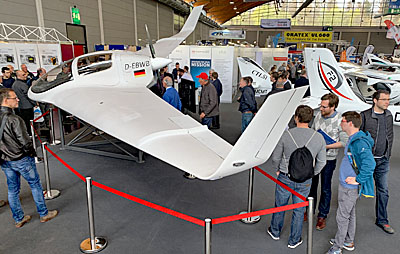 You may have already jumped to the point about those wings being exactly where the
You may have already jumped to the point about those wings being exactly where the 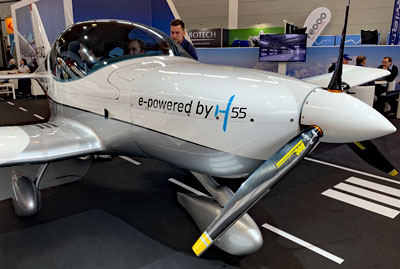 The company is now taking their smooth aircraft and powering it with an electric motor. They call the project B23 H55 Energic. The motor can deliver 90 kW (122 horsepower) for takeoff at 900 fpm and 65 kW (88 horsepower) for continuous cruise power at 125 mph. Onboard batteries can deliver one hour of endurance with a 20-minute reserve. Fully recharging will take only about 30 minutes. BRM estimates the cost of operation at $7/hour, less than the cost of one gallon of fuel at current European prices for avgas.
The company is now taking their smooth aircraft and powering it with an electric motor. They call the project B23 H55 Energic. The motor can deliver 90 kW (122 horsepower) for takeoff at 900 fpm and 65 kW (88 horsepower) for continuous cruise power at 125 mph. Onboard batteries can deliver one hour of endurance with a 20-minute reserve. Fully recharging will take only about 30 minutes. BRM estimates the cost of operation at $7/hour, less than the cost of one gallon of fuel at current European prices for avgas.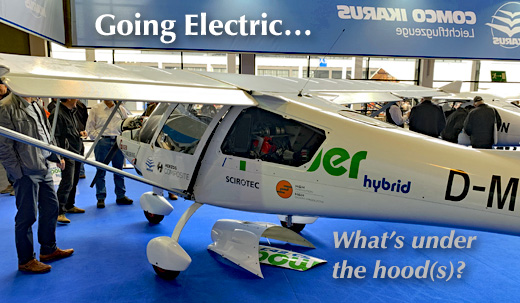
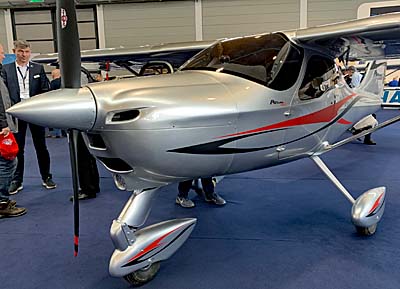 Tecnam P92 Mk II
Tecnam P92 Mk II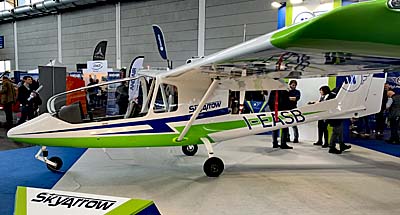 Magnaghi SkyArrow
Magnaghi SkyArrow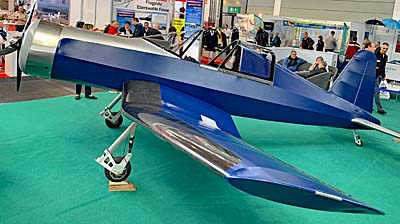 JH Aircraft Corsair
JH Aircraft Corsair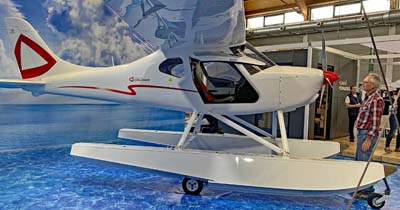 CSA Delta Cruiser
CSA Delta Cruiser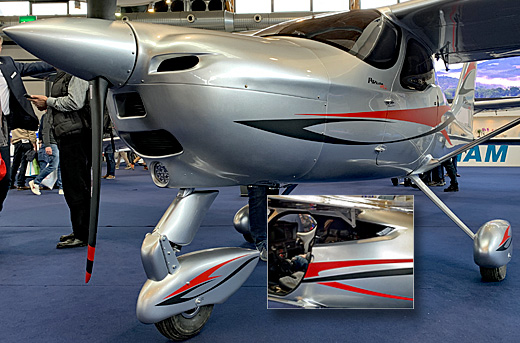
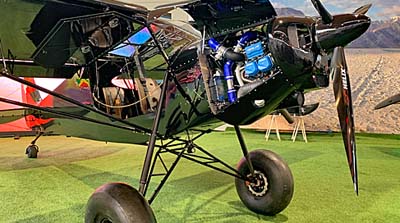 Zlin Ultra with Rotax 915iS
Zlin Ultra with Rotax 915iS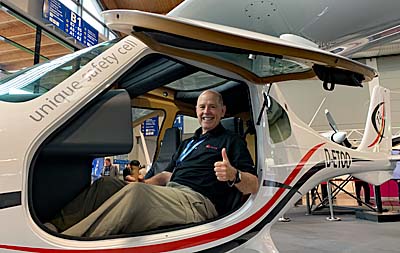
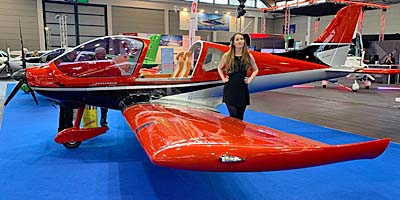 Belmont Aero DW200
Belmont Aero DW200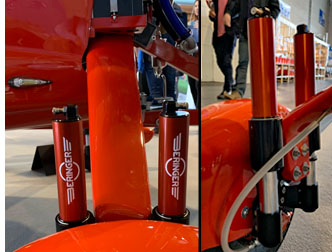 Beringer Everywhere
Beringer Everywhere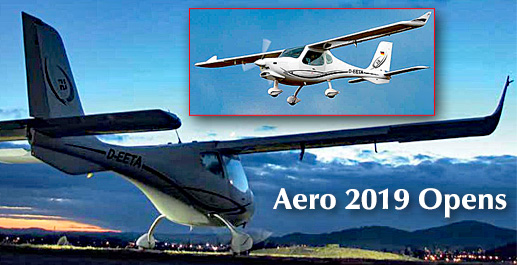
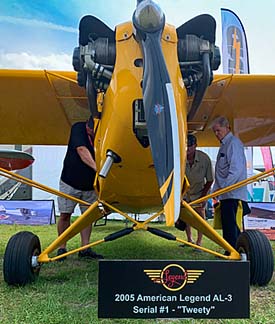 Sun ‘n Fun is over. While staff, tent vendors and more have plenty of work to do, customers and vendors have all vacated the area, scattering off across the USA as they return to base.
Sun ‘n Fun is over. While staff, tent vendors and more have plenty of work to do, customers and vendors have all vacated the area, scattering off across the USA as they return to base.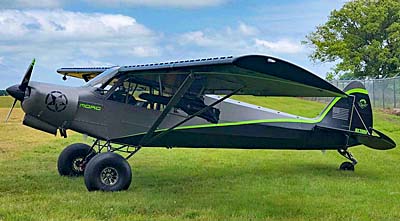 However, it was the Mother Of All Cubs that commandeered the focus of many show attendees visiting the American Legend exhibit. This variation on their theme has several wow factors.
However, it was the Mother Of All Cubs that commandeered the focus of many show attendees visiting the American Legend exhibit. This variation on their theme has several wow factors.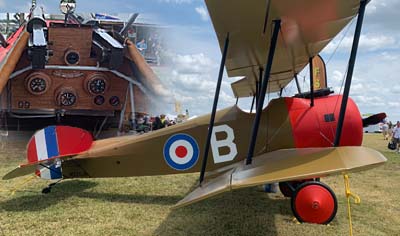 The movie people saw the precision of his replicas. These are vintage aircraft built as closely as possible to their original but using modern materials and techniques. Under the authentic looking exterior is a welded steel frame. Aerodrome supplies these elements for kit builders. Movie studios may stimulate a design, by Baslee’s creations have also enabled a following that loves the vintage look.
The movie people saw the precision of his replicas. These are vintage aircraft built as closely as possible to their original but using modern materials and techniques. Under the authentic looking exterior is a welded steel frame. Aerodrome supplies these elements for kit builders. Movie studios may stimulate a design, by Baslee’s creations have also enabled a following that loves the vintage look.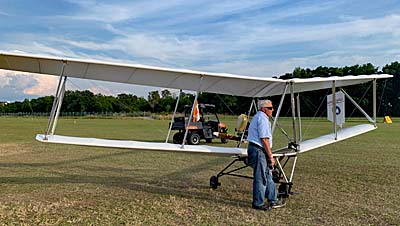 At Sun ‘n Fun, as he has so often done, John flew an Easy Riser much like his original from 45 years ago. A mere 15 horsepower, shifting weight fore and aft to change pitch, no landing gear, no instrumentation needed.
At Sun ‘n Fun, as he has so often done, John flew an Easy Riser much like his original from 45 years ago. A mere 15 horsepower, shifting weight fore and aft to change pitch, no landing gear, no instrumentation needed.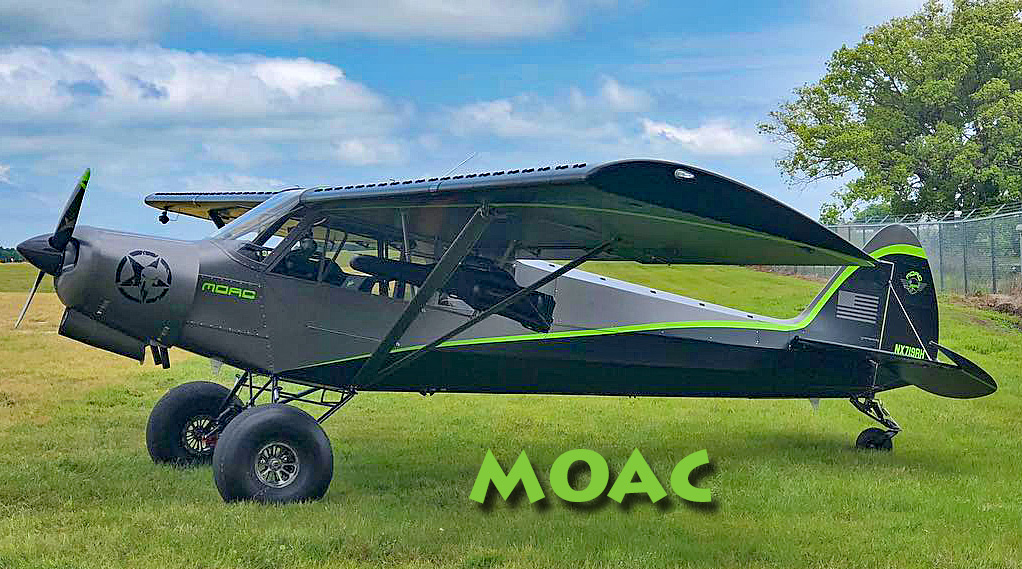
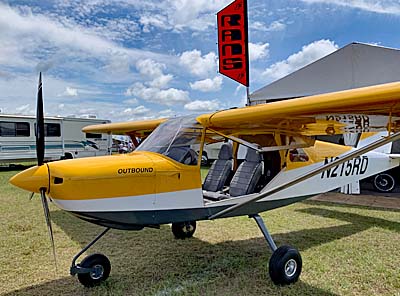 Sun ‘n Fun streaks on with Blue Angels and Stearmans cracking the air. Exhibits are active. People are shopping for the right airplane. Strong crowds were present at peak times. Opening day may have set a record. Generally vendors and customers seemed to be in good spirits. Recreational aviation looks healthy.
Sun ‘n Fun streaks on with Blue Angels and Stearmans cracking the air. Exhibits are active. People are shopping for the right airplane. Strong crowds were present at peak times. Opening day may have set a record. Generally vendors and customers seemed to be in good spirits. Recreational aviation looks healthy.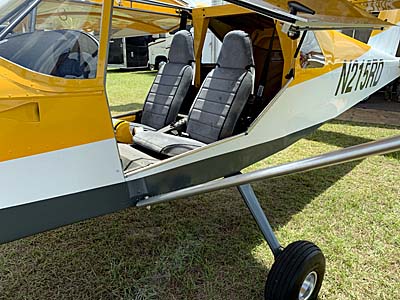 The trouble is, for the last two generations of pilots, nearly all were instructed in a tricycle gear airplane. Most have also heard stories about ground loops causing damage and hurting pride. They stick to tricycle gear and given their training, that’s probably appropriate. For Sun ‘n Fun 2019, Rans brought Outbound in tricycle gear. Despite what many might have expected the configuration looks good.
The trouble is, for the last two generations of pilots, nearly all were instructed in a tricycle gear airplane. Most have also heard stories about ground loops causing damage and hurting pride. They stick to tricycle gear and given their training, that’s probably appropriate. For Sun ‘n Fun 2019, Rans brought Outbound in tricycle gear. Despite what many might have expected the configuration looks good.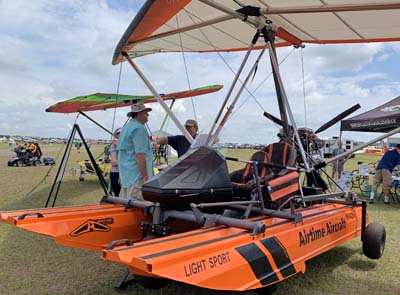 With the tricycle gear, you can have robust but smaller tires or you can opt for the tricycle version of bush gear; doing so gives greater prop clearance for larger diameters. All outbounds can go both ways, taildragger or tri-gear. It takes about four hours to swap out the hardware but the airframe is built to accommodate either configuration.
With the tricycle gear, you can have robust but smaller tires or you can opt for the tricycle version of bush gear; doing so gives greater prop clearance for larger diameters. All outbounds can go both ways, taildragger or tri-gear. It takes about four hours to swap out the hardware but the airframe is built to accommodate either configuration.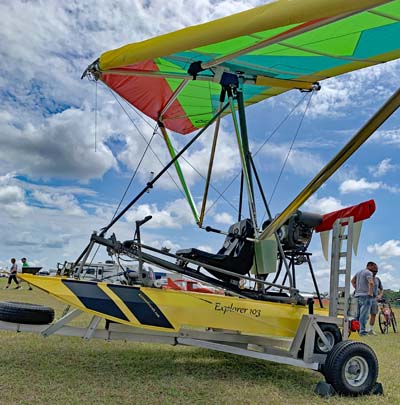 Airtime has the trike carriage attached optimally to the floats to complement this quality of trikes and the results are good. I watched as Michael cycled the gear up and down (look for a mini video as soon as I find time). It’s a remarkably fast moving system and appears very simple. This system is used in two configurations on both the company’s aircraft.
Airtime has the trike carriage attached optimally to the floats to complement this quality of trikes and the results are good. I watched as Michael cycled the gear up and down (look for a mini video as soon as I find time). It’s a remarkably fast moving system and appears very simple. This system is used in two configurations on both the company’s aircraft.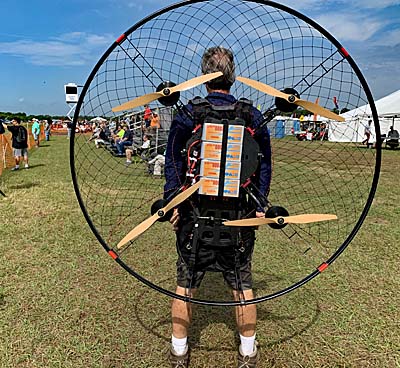 I learned of this from
I learned of this from 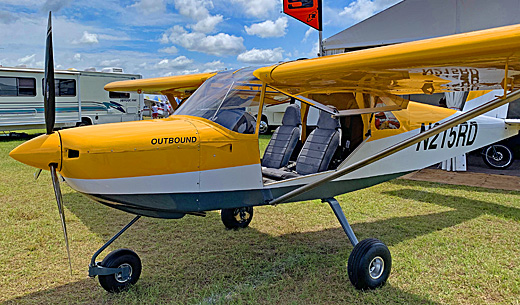
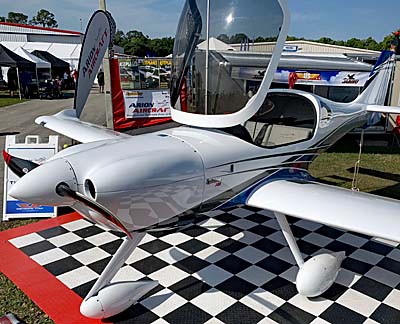 Now, ultralight pilots (me, for instance) will go on enthusiastically about the beauty of flying slowly, of drifting leisurely over the landscape at a “human speed” that allows enough time to enjoy the expanse of an aerial view of your surroundings. Open cockpit flying adds to the joy facilitated by low airspeeds.
Now, ultralight pilots (me, for instance) will go on enthusiastically about the beauty of flying slowly, of drifting leisurely over the landscape at a “human speed” that allows enough time to enjoy the expanse of an aerial view of your surroundings. Open cockpit flying adds to the joy facilitated by low airspeeds.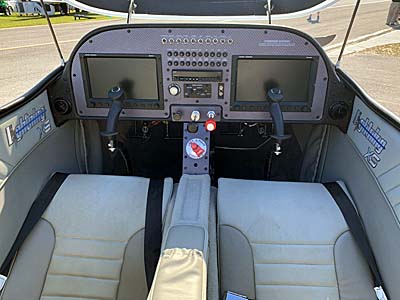 Lightning has enjoyed and continues to execute a good run but like many designers, Nick felt the design could handle more speed. He set out to bump the numbers by installing a Titan X340 with 180 horsepower. This triggered other changes such as a new cowl to accommodate the powerplant.
Lightning has enjoyed and continues to execute a good run but like many designers, Nick felt the design could handle more speed. He set out to bump the numbers by installing a Titan X340 with 180 horsepower. This triggered other changes such as a new cowl to accommodate the powerplant.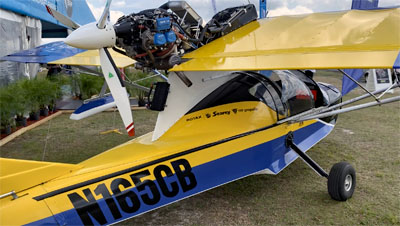
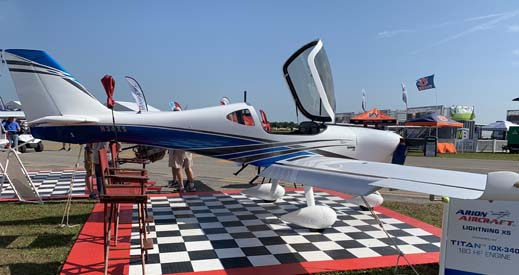
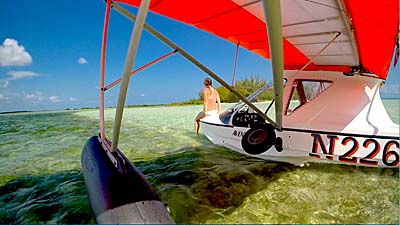
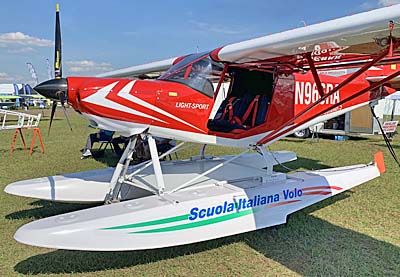
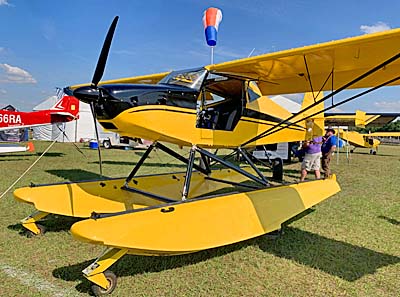
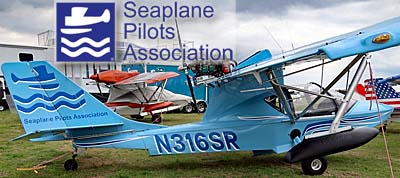
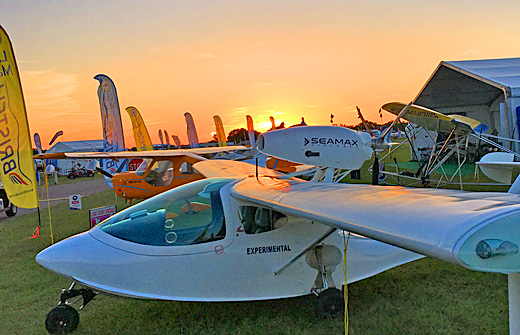
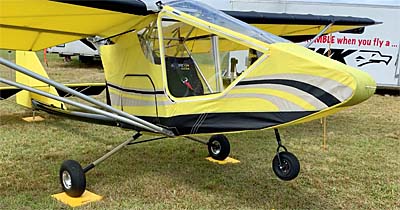
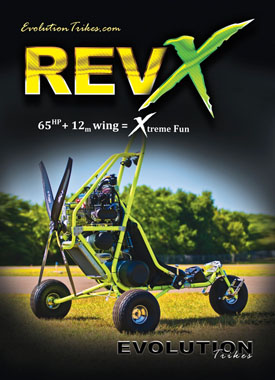
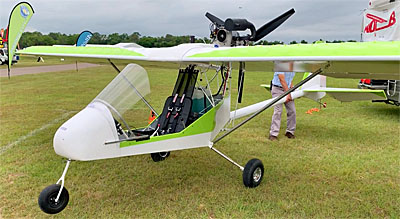
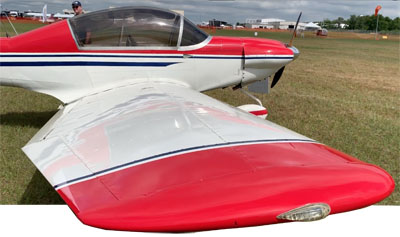
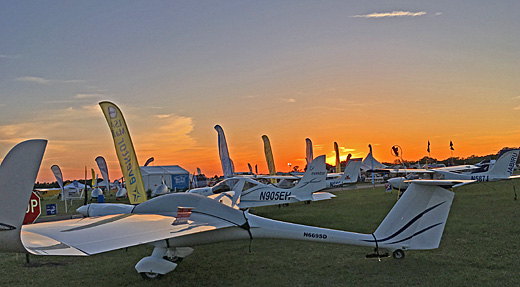
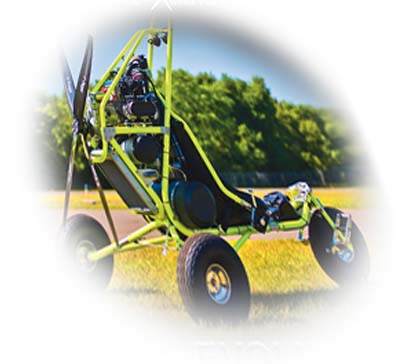
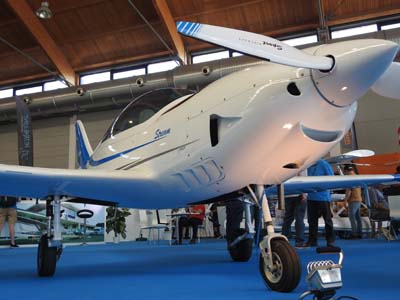 Welcome to Stream, a carbon fiber, low wing, tandem seating, retractable gear lightplane. Stream is clearly part of the TL family but is completely different than the preceding two models — that Americans already know.
Welcome to Stream, a carbon fiber, low wing, tandem seating, retractable gear lightplane. Stream is clearly part of the TL family but is completely different than the preceding two models — that Americans already know.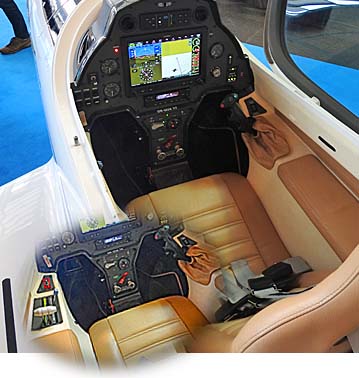 The U.S. based company, with roots in the origin country of Czech Republic, is displaying a Sting, a turbo Sting, the company’s high wing Sirius, and Stream. The example was built as it must be for the American market as an Experimental Amateur Built model. A husband and wife team just return from a month in Czech Republic where they fulfilled all requirements for FAA approval. It is their airplane on display.
The U.S. based company, with roots in the origin country of Czech Republic, is displaying a Sting, a turbo Sting, the company’s high wing Sirius, and Stream. The example was built as it must be for the American market as an Experimental Amateur Built model. A husband and wife team just return from a month in Czech Republic where they fulfilled all requirements for FAA approval. It is their airplane on display.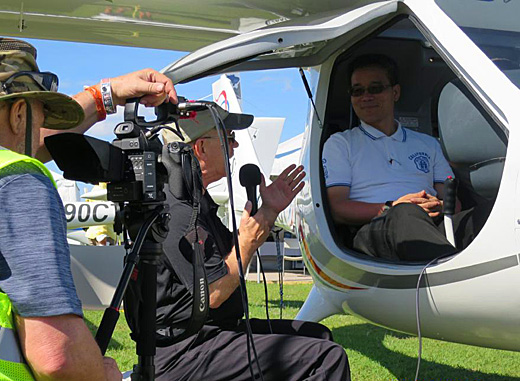
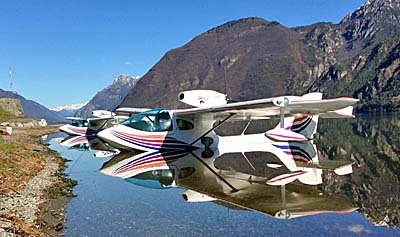 Most Americans know the childhood story about the “Little Engine that Could,” a tale of determination, working against long odds and succeeding despite them. I think that relates to SeaMax.
Most Americans know the childhood story about the “Little Engine that Could,” a tale of determination, working against long odds and succeeding despite them. I think that relates to SeaMax.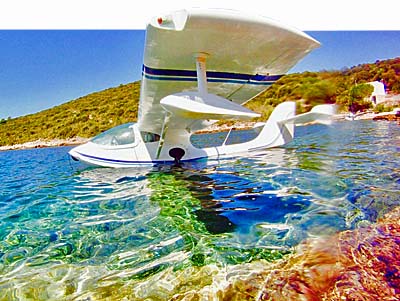 Perhaps even more important,
Perhaps even more important, 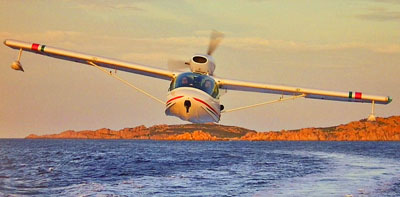 The Brazilian company, with
The Brazilian company, with 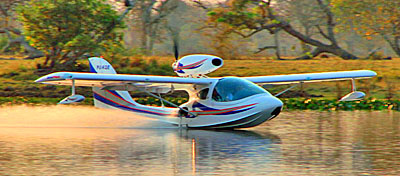 For those who cannot attend Sun ‘n Fun 2019, the company has a permanent aircraft in south Florida where it can offer introductory flights to customers.
For those who cannot attend Sun ‘n Fun 2019, the company has a permanent aircraft in south Florida where it can offer introductory flights to customers.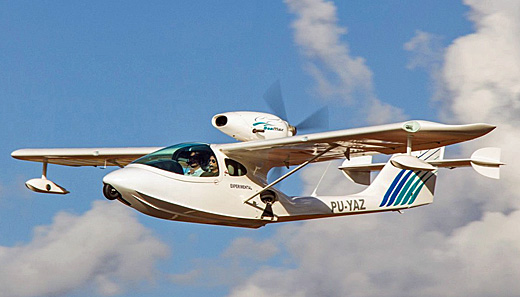
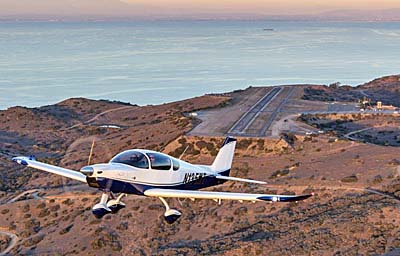 Intended Departure: Sunday at 4 AM Pacific • Landing Florida before 7 PM Eastern in a flight forecast to take “under 12 hours” at a predicted speed of 160 knots (184 mph), at altitude.
Intended Departure: Sunday at 4 AM Pacific • Landing Florida before 7 PM Eastern in a flight forecast to take “under 12 hours” at a predicted speed of 160 knots (184 mph), at altitude.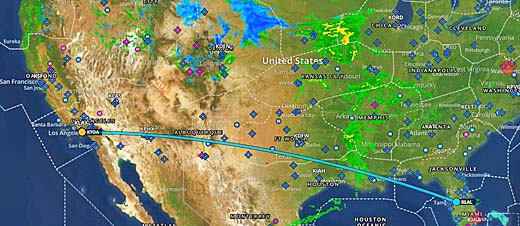 Sling TSi has standard tanks of 45 gallons capacity or optional long-range wing tip tanks that add an additional 22 gallons plus an internal portable tanks of 20 gallons for a grand total of 87 gallons on board.
Sling TSi has standard tanks of 45 gallons capacity or optional long-range wing tip tanks that add an additional 22 gallons plus an internal portable tanks of 20 gallons for a grand total of 87 gallons on board.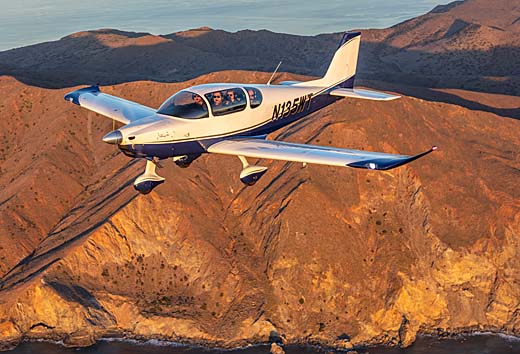
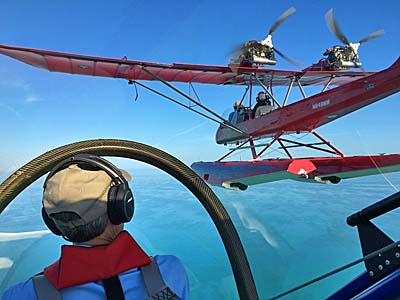 Let me admit right up front: I am a big fan of AirCam. I have flown several different examples. I have done a flight report in one with boss Phil Lockwood. I even earned my Multi-Engine Rating in one. For a longtime open-cockpit ultralight pilot like me, AirCam may be the ultimate expression of a fun aircraft in which you can do things you shouldn’t even consider in most other airplanes.
Let me admit right up front: I am a big fan of AirCam. I have flown several different examples. I have done a flight report in one with boss Phil Lockwood. I even earned my Multi-Engine Rating in one. For a longtime open-cockpit ultralight pilot like me, AirCam may be the ultimate expression of a fun aircraft in which you can do things you shouldn’t even consider in most other airplanes.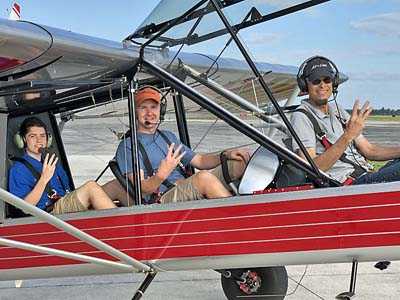 The third seat can be installed in either an open-cockpit AirCam or one with the full enclosure canopy. The canopy — developed some years after AirCam first emerged — was designed from the start to accommodate the third seat.
The third seat can be installed in either an open-cockpit AirCam or one with the full enclosure canopy. The canopy — developed some years after AirCam first emerged — was designed from the start to accommodate the third seat.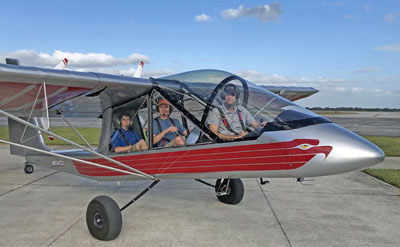 Being Rotax experts known across the country, Lockwood’s enterprise was ready to step up the potency of their twin engines.
Being Rotax experts known across the country, Lockwood’s enterprise was ready to step up the potency of their twin engines.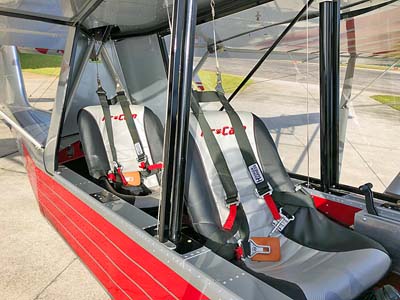 “The additional 15 horsepower per engine is achieved though an increase in displacement with no increase in weight.” Customers may purchase or retrofit either a carbureted 912 ULS or fuel injected 912iS engine package to provide 115-horsepower upgrades for either engine model. Buyers or owners can opt to install the 115-horsepower package at a later date.
“The additional 15 horsepower per engine is achieved though an increase in displacement with no increase in weight.” Customers may purchase or retrofit either a carbureted 912 ULS or fuel injected 912iS engine package to provide 115-horsepower upgrades for either engine model. Buyers or owners can opt to install the 115-horsepower package at a later date.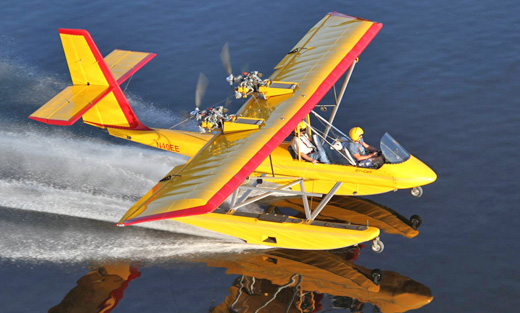
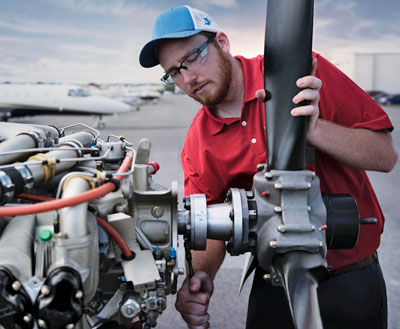 A few years ago, I visited Continental Motors in Mobile Alabama on the Gulf coast of the southern U.S. state.
A few years ago, I visited Continental Motors in Mobile Alabama on the Gulf coast of the southern U.S. state.
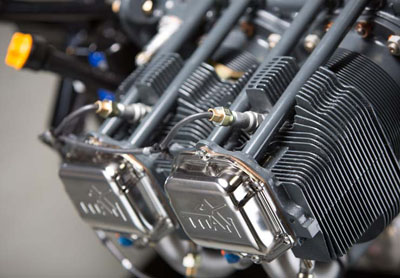
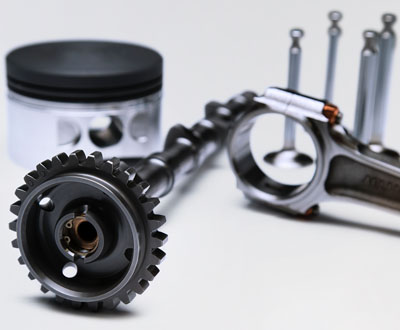
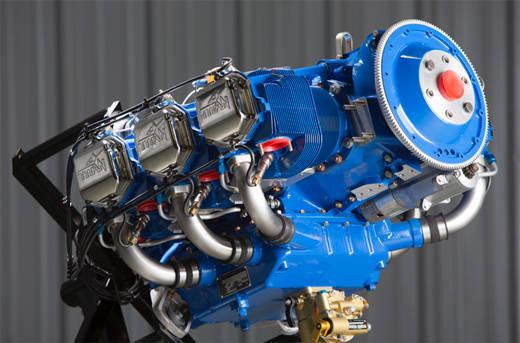
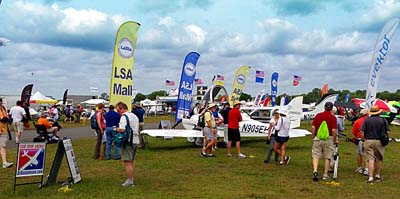 This year celebrates 15 years of Light-Sport Aircraft and its companion pilot certificate, Sport Pilot. This year also celebrates the 12th year of LAMA providing the LSA Mall. What a fascinating ride it has been!
This year celebrates 15 years of Light-Sport Aircraft and its companion pilot certificate, Sport Pilot. This year also celebrates the 12th year of LAMA providing the LSA Mall. What a fascinating ride it has been!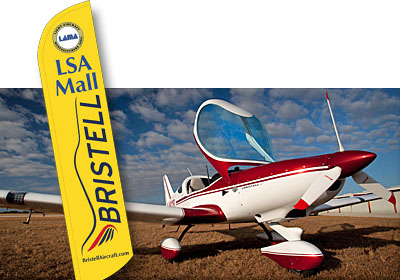 For 2019, the LSA Mall will add a few previously-owned LSA, as this part of the light aircraft market is developing. I’ve
For 2019, the LSA Mall will add a few previously-owned LSA, as this part of the light aircraft market is developing. I’ve 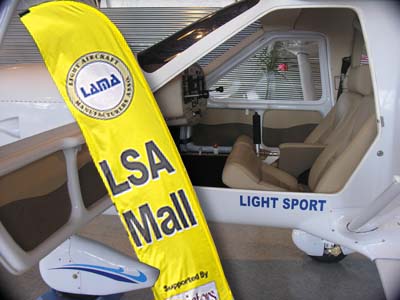 In addition to dozen Light-Sport Aircraft and Sport Pilot kits all parked wingtip-to-wingtip, LAMA will also again host a display of engines used on Light-Sport Aircraft and Sport Pilot kits.
In addition to dozen Light-Sport Aircraft and Sport Pilot kits all parked wingtip-to-wingtip, LAMA will also again host a display of engines used on Light-Sport Aircraft and Sport Pilot kits.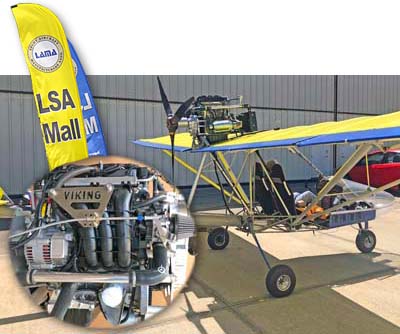 If you visit the core area of Sun ‘n Fun, you know it is a fair walk to Paradise City. Yet it is a great draw as many see that Sun ‘n Fun’s “alternate airport” in Paradise City represents something of an airshow-within-an airshow.
If you visit the core area of Sun ‘n Fun, you know it is a fair walk to Paradise City. Yet it is a great draw as many see that Sun ‘n Fun’s “alternate airport” in Paradise City represents something of an airshow-within-an airshow.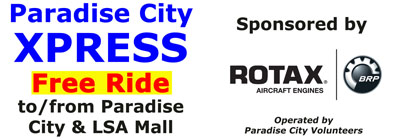 Look for the golf carts with the Rotax logo prominently displayed and stick your thumb out for a ride.
Look for the golf carts with the Rotax logo prominently displayed and stick your thumb out for a ride.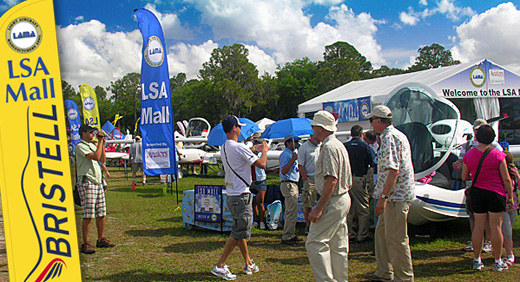
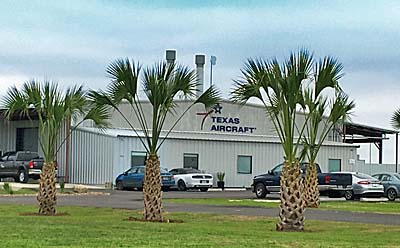 In late February, Texas Aircraft invited me to an unveiling ceremony. As it’s always wonderful to witness the arrival of a new aircraft and sense the excitement and enthusiasm of its developers, I jumped at the opportunity.
In late February, Texas Aircraft invited me to an unveiling ceremony. As it’s always wonderful to witness the arrival of a new aircraft and sense the excitement and enthusiasm of its developers, I jumped at the opportunity.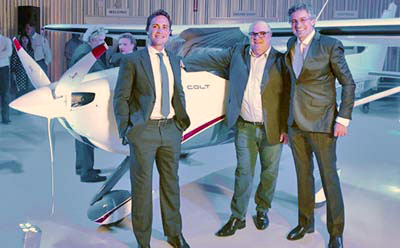
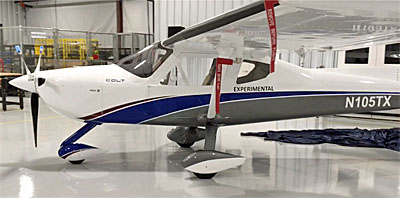 “We cannot thank the people of Hondo enough for the loving welcome we have received since coming here,” Barros said. “The leadership and people of Hondo have made this possible. We are proudly genuine sons and daughters of Hondo. We are confident that we will make Hondo deeply proud of us.”
“We cannot thank the people of Hondo enough for the loving welcome we have received since coming here,” Barros said. “The leadership and people of Hondo have made this possible. We are proudly genuine sons and daughters of Hondo. We are confident that we will make Hondo deeply proud of us.”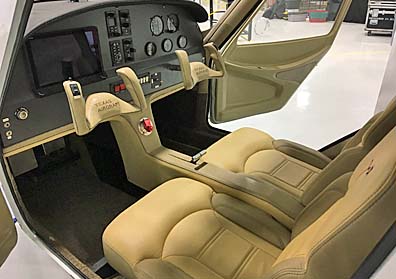 In addition to Hondo city officials including the mayor, Lyndsey Dennis represented Texas Governor Gregg Abbott’s Office of Economic Development and presented a certificate signed by the Governor congratulating the Texas Aircraft Manufacturing team with their accomplishment
In addition to Hondo city officials including the mayor, Lyndsey Dennis represented Texas Governor Gregg Abbott’s Office of Economic Development and presented a certificate signed by the Governor congratulating the Texas Aircraft Manufacturing team with their accomplishment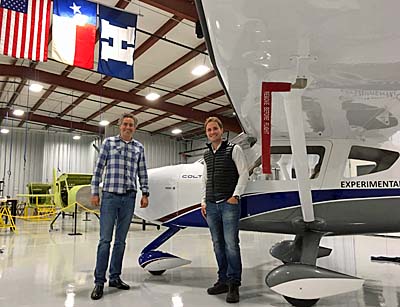 Powered by a Rotax 912 swinging a Sterno composite prop, Colt is an all-metal, tricycle gear design based on a previous-generation aircraft that
Powered by a Rotax 912 swinging a Sterno composite prop, Colt is an all-metal, tricycle gear design based on a previous-generation aircraft that 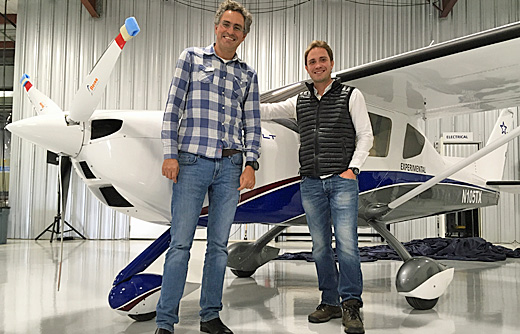
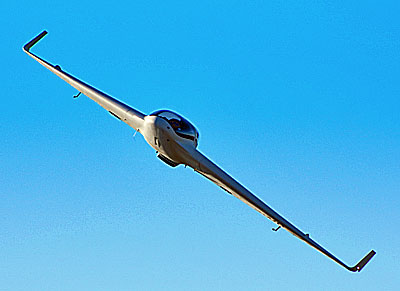 In 1943, Reichsmarschall Göring issued a request for design proposals to produce a bomber that was capable of carrying a 1,000 kilogram (2,200 pound) load over 1,000 kilometers (620 miles) at 1,000 kilometers per hour (620 mph) — the so-called “3×1000 project.” Conventional German bombers could reach Allied command centers in Great Britain, but were suffering devastating losses from Allied fighters.
In 1943, Reichsmarschall Göring issued a request for design proposals to produce a bomber that was capable of carrying a 1,000 kilogram (2,200 pound) load over 1,000 kilometers (620 miles) at 1,000 kilometers per hour (620 mph) — the so-called “3×1000 project.” Conventional German bombers could reach Allied command centers in Great Britain, but were suffering devastating losses from Allied fighters.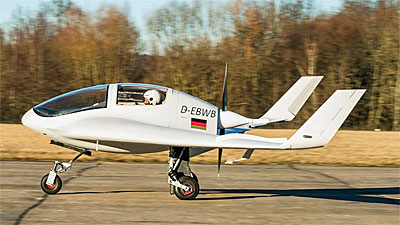 The Government Air Ministry approved the Horten proposal, but ordered the addition of two 30-mm cannons because they felt the aircraft would also be useful as a fighter as its estimated top speed was significantly higher than that of any Allied aircraft.
The Government Air Ministry approved the Horten proposal, but ordered the addition of two 30-mm cannons because they felt the aircraft would also be useful as a fighter as its estimated top speed was significantly higher than that of any Allied aircraft.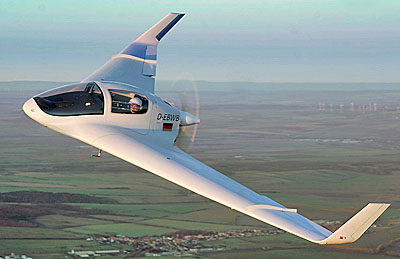
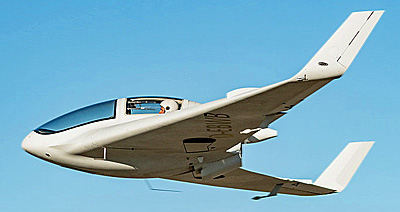 At this time, the company is not disclosing any pertinent data about the aircraft but I will be at
At this time, the company is not disclosing any pertinent data about the aircraft but I will be at 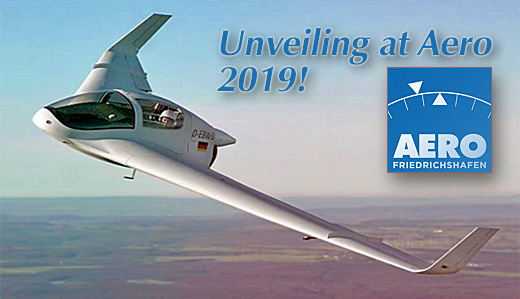
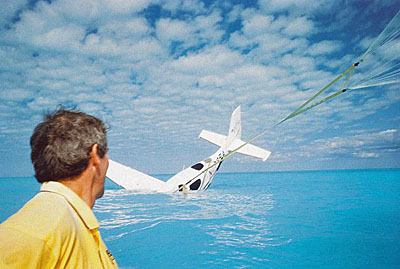 “You just saved my life!” It’s not often anyone, even a medical doctor, hears those words. Back in the ’90s I was sometimes on the receiving end of a call when a pilot phoned BRS to report a “save,” a sparing of a life by the use of a parachute. It is a humbling experience to have someone exclaim that you (and your fellow workers) are the reason they are alive.
“You just saved my life!” It’s not often anyone, even a medical doctor, hears those words. Back in the ’90s I was sometimes on the receiving end of a call when a pilot phoned BRS to report a “save,” a sparing of a life by the use of a parachute. It is a humbling experience to have someone exclaim that you (and your fellow workers) are the reason they are alive.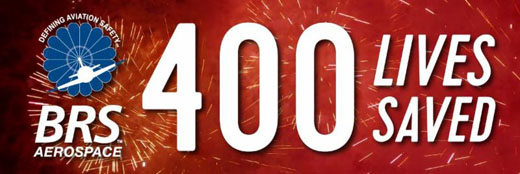 The system is designed to be a last resort for pilots and passengers when all other attempts to recover the airplane in case of emergency or pilot incapacitation have failed.
The system is designed to be a last resort for pilots and passengers when all other attempts to recover the airplane in case of emergency or pilot incapacitation have failed.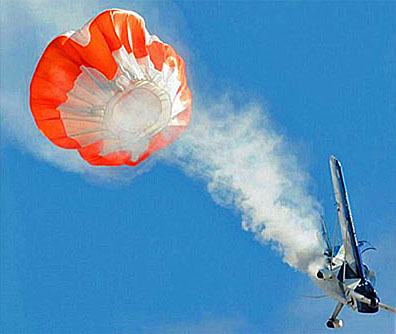
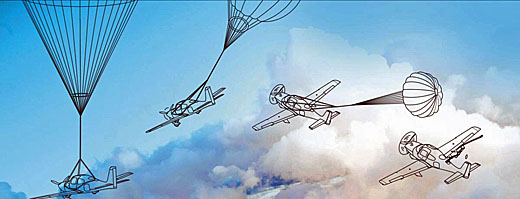 Numerous European and U.S. ultralight and experimental aircraft use the system, including Lancair, Carbon Cub, Kitfox, Glassair,
Numerous European and U.S. ultralight and experimental aircraft use the system, including Lancair, Carbon Cub, Kitfox, Glassair, 